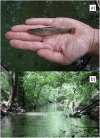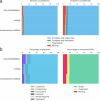An updated reference genome of Barbatula barbatula (Linnaeus, 1758)
- PMID: 39843539
- PMCID: PMC11754907
- DOI: 10.1038/s41597-025-04469-z
An updated reference genome of Barbatula barbatula (Linnaeus, 1758)
Abstract
The stone loach Barbatula barbatula is a benthic fish species widely distributed throughout Europe, primarily inhabiting stony upper sections of stream networks. This study presents an updated genome assembly of B. barbatula, contributing to the species' available genomic resources for downstream applications such as conservation genetics. The draft assembly was 550 Mbp in size, with an N50 of 11.21 Mbp. We used the species' available chromosome scaffolds to finish the genome. The final assembly had a BUSCO score of 96.7%. We identified 23270 protein-coding genes, and the proteome exhibited high completeness with BUSCO (93.1%) and OMArk (90.81%). Despite using multiple approaches to reduce duplicate contigs, we observed a relatively high duplicate ratio of 6.1% (BUSCO) and 8.52% (OMArk) in the annotations. We aimed to find microsatellite loci present in both the species' publicly available genome and the new assembly to aid marker development for downstream analyses. This dataset serves as a reference for genomic analysis and is useful for developing markers to study the species' biodiversity and support conservation efforts.
© 2025. The Author(s).
Conflict of interest statement
Competing interests: The authors declare no competing interests.
Figures




Similar articles
-
Diagnostic test accuracy and cost-effectiveness of tests for codeletion of chromosomal arms 1p and 19q in people with glioma.Cochrane Database Syst Rev. 2022 Mar 2;3(3):CD013387. doi: 10.1002/14651858.CD013387.pub2. Cochrane Database Syst Rev. 2022. PMID: 35233774 Free PMC article.
-
Signs and symptoms to determine if a patient presenting in primary care or hospital outpatient settings has COVID-19.Cochrane Database Syst Rev. 2022 May 20;5(5):CD013665. doi: 10.1002/14651858.CD013665.pub3. Cochrane Database Syst Rev. 2022. PMID: 35593186 Free PMC article.
-
Two new species of stone loaches of the genus Barbatula (Cypriniformes: Nemacheilidae) from Europe with a neotype designation of B. barbatula (Teleostei: Nemacheilidae).J Fish Biol. 2025 Jul 2. doi: 10.1111/jfb.70108. Online ahead of print. J Fish Biol. 2025. PMID: 40605267
-
Drugs for preventing postoperative nausea and vomiting in adults after general anaesthesia: a network meta-analysis.Cochrane Database Syst Rev. 2020 Oct 19;10(10):CD012859. doi: 10.1002/14651858.CD012859.pub2. Cochrane Database Syst Rev. 2020. PMID: 33075160 Free PMC article.
-
Systemic pharmacological treatments for chronic plaque psoriasis: a network meta-analysis.Cochrane Database Syst Rev. 2021 Apr 19;4(4):CD011535. doi: 10.1002/14651858.CD011535.pub4. Cochrane Database Syst Rev. 2021. Update in: Cochrane Database Syst Rev. 2022 May 23;5:CD011535. doi: 10.1002/14651858.CD011535.pub5. PMID: 33871055 Free PMC article. Updated.
References
-
- Kottelat, M. & Freyhof, J. Handbook of European Freshwater Fishes. (Kottelat and Freyhof, Cornol, Switzerland, Berlin, Germany, 2007).
-
- FishBase. https://fishbase.se/search.php (2023).
-
- Erős, T. & Campbell Grant, E. H. Unifying research on the fragmentation of terrestrial and aquatic habitats: Patches, connectivity and the matrix in riverscapes. Freshwater Biology60, 1487–1501, 10.1111/fwb.12596 (2015).
-
- Erős, T. Scaling fish metacommunities in stream networks: Synthesis and future research avenues. Community Ecology18, 72–86, 10.1556/168.2017.18.1.9 (2017).
-
- Henriques-Silva, R. et al. A comprehensive examination of the network position hypothesis across multiple river metacommunities. Ecography42, 284–294, 10.1111/ecog.03908 (2019).
Publication types
MeSH terms
LinkOut - more resources
Full Text Sources
Miscellaneous

